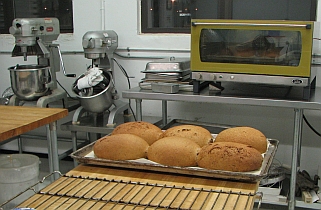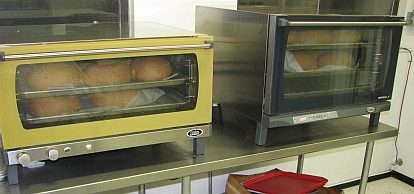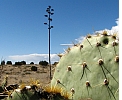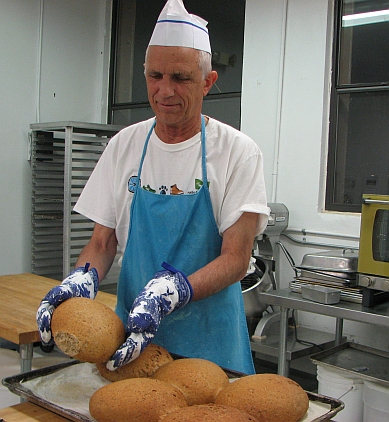Baking notes
For those who are interested in what's involved in starting and running a small bakery without professional baking experience, I thought I'd write these occasional notes. Bread lovers who don't bake may also find them interesting. They're in reverse order of date, with the most recent notes first.
5.17.16 Quality fluctuation
The last bake was unsatisfactory. The dough didn't feel elastic and the loaves rose poorly. Was this because of a change to a cheaper WW flour? But even the 8-grain bread was disappointing, and it doesn't contain any of the new WW.
European whole-grain baking (which I try to emulate in my untrained way) employs U.S. hard winter wheat for high protein, which provides the high gluten that supports dough expansion. I'll experiment with different WW flours and may have to return to the expensive stuff to get the handsomely expanded loaves that everyone, including me, likes to slice.
3.18.16 Potato and bread
I've found that using cooked potato in bread improves its moisture content and slows staling. Books will likely tell you this, but until you find out for yourself, it's not that convincing. You don't get a potato taste; you just get a nice moist texture.
1.1.16 Baker progress 2
We've obtained a proofing cabinet. This is a big (accommodating maybe 25 loaves) glass-fronted steel box with shelves, a water pan, and a heating element. It's used for keeping dough warm while humidifying the air around it so that the surface doesn't dry out. Until now I was using another box of about the same size but without any heating or humidifier. I would boil a couple of gallons of water and pour it into a pan at the bottom. It worked OK, but took more work than the new cabinet, as I'd have to reheat the water every 20 min or so.
The breads have shown better and more consistent volume since I've been able to keep the dough consistently warm and moist. A domed loaf has better eye appeal than one that barely rises above the pan, even though the taste and texture may differ little. Next is to start kicking up the whole-grain percentage in the breads.
8.21.15 Baker progress 1
This was a successful bake—all loaves had good volume even with substantial (55% or more) whole-grain content. What are the keys? So far my observations are 1) Let the dough be sticky. It's messier to handle, but that's the price of a fat loaf. 2) Keep the proofing cabinet warm. 3) Use diastatic malt powder (only 0.15% by weight is needed; that's less than 1 g per loaf) in dough for wheaten breads. 4) Watch the dough as it's mixing. If it's too liquid, throw in flour. If it's too dry, add water. More than this I can't advise, as you really have to be there and know what "too liquid" and "too dry" mean in practice.
A note on sourness: I like a touch of sour, but when the bread starts dissolving my tooth enamel I draw the line. A dough for 6 loaves is now prepped with 50 to 80 g of sourdough starter (in around 2500 g of flour, finally) and let develop for 7 hours in a warm area. Or prepped with more sour and developed fewer hours, or in the cold.
A note on salt: Although I try to stay short of Panera bread saltiness (Panera is a popular chain of coffee/light meal shops), I've been too frugal at around 4 g per 680-g loaf. Kicking it up to 5 g.
6.5.15 More hydration
Guess I'm a slow learner. Today's breads were compact and hard, except for one whose dough was the stickiest I've ever handled, and it gave a high-rising, light loaf whose crumb was still soft 36 hours later. Lesson: good dough will be sticky. Don't keep adding flour to make it quit sticking so much; it will also stop rising.
We sold out, but I'm not satisfied.
5.1.15 Hydration and sourness
Today's batch turned out pretty well. The starter (250 g for about 1200 g flour, mixed 7 h in advance of bulk mixing) imparted good (but still, to my taste, excessive) sourness. All doughs were mixed to 60% hydration (60 parts by weight of water to 100 of flour), but even lower would have worked for some of them. This is surprising to me. Kneading by hand, I'm used to developing a dough that isn't very sticky. Mixing with the machine even at 60% hydration usually develops a very sticky dough, though one with good elasticity. That dough bakes up well, if confined in a pan where it can't sprawl out.
Today's bake finished 37 loaves, of 5 types, in 4.5 h. Still room for efficiency improvement.
4.24.15 Acidity
I thought the sprouted-wheat bread was overly sour. This is easily remedied by preparation of only a limited amount of starter rather than souring the bulk dough. Ideally you do the test before going to market! We don't mind freezing and eating the loaves that don't sell, but it's nice to try the fresh ones too.
4.17.15 Dough temp and overmixing
With these four batches I made two mistakes:
1) I prepared in advance all the starter for each batch at once, leaving no chance to adjust the dough temperature by adding warm water. Even in a warm proofing cabinet, the dough never warmed up, and stayed sluggish and stiff.
2) I may have overmixed the dough during bulk mixing. These power mixers are splendid machines, but mixing for too long overdevelops the gluten (which provides elasticity) at the expense of extensibility.
So all four loaf types were too small, dense, and resistant to slicing. If customers think that all our loaves will be like this, they may not come back. Part of the reason is having to bake at a location half an hour's drive distant from the baker's home. All of these breads are prepared with starters, beginning a day and a half in advance. It's best if these can be prepared in the bakery.
4.3.15 Handling hydration, ramping up production
The right hydration remains elusive, at least when the recipe is being varied for experiment's sake. When the dough is sticking to the mixing bowl walls and bottom, it's going to be sticky to handle when loaves are shaped. I carefully throw in more bread flour, but then decide to bake the loaves in loaf pans to avoid sprawl. I'd think the baked loaf would be moister than one from a less hydrated dough, but these weren't, although they were nicely chewy.
This evening I finished 27 loaves in 3.5 h, so a goal of 80 in 8 h of singlehanded work seems realistic, though tiring. Admittedly, the dry ingredients were weighed out at home, and the starter preparation also took time.
3.27.15 Reducing whole-grain content has pleasing effects
Yep, it's easier to bake with white flour. The loaves this week, by design, had about 50% whole grain, in contrast to previous loaves of 75%. They had good volume, good sour but not overly sour taste, chewy crumb and crust, and several days of shelf life. I'll be playing with these recipes for a while, as the loaves are likely to be more popular than the heavier whole-grain ones. But the goal remains to make delightful all-whole-grain breads.
3.13.15 Sesame and seven-grain breads
The seven-grain dough, at 63% hydration, was very sticky but the bread was pleasing, with good ovenspring and flavor. The sesame dough at 62% was a bit stiffer but felt about right. But there seems to be some kind of yeast inhibitor in sesame seed. I've never succeeded in baking a light sesame-seed bread. Other seeds (sunflower, pumpkin) do fine. [Added note: 5/15 bake blew a hole in this notion: sesame bread had good volume. Seed was presoaked but didn't absorb much water. I'm guessing the key was mostly dough temp.]
3.6.15 Tuning recipes, equipment, and procedures
I've hired a helper mostly to sell the bread. Though I'd like to meet the customers, I'm otherwise occupied at the market time. As we bake larger volumes, we'll need to optimize the procedure. My current goal is 100 loaves in an 8-h working day with two people, but I expect that we can do much better. At present we need to develop the market.
A second reading of Jeffrey Hamelman's book (Bread: A Baker's Book of Techniques and Recipes; John Wiley & Sons, Inc., 2004) reminded me about the use of the mixer; first (lowest) speed to mix the ingredients, and second speed to develop the dough strength. On the third bake, I mixed batches of 7.8 kg to make 10 loaves, using the left-hand mixer shown below. For the two whole wheat (WW) breads that I designed for 63% hydration and dough temperatures (not measured) in the 70s to 80s, no adjustment was necessary, and the prescribed steaming treatment led to nice ovenspring (see the 2.27 entry, below, for explanation). For the rye bread with presoaked rye meal, I messed up the water estimation badly (probably on account of the soaking liquid) and the dough was semiliquid. I rescued the loaves by hand-kneading in some bread flour after bulk fermentation, but this is a waste of time and the bread wasn't as light as it could have been. Why don't I just use Hamelman's tested recipes? I'm getting there—just reluctant to abandon creativity.
The helper made herself useful by doing almost all the cleanup. Later the idea will be that she mixes, proofs, etc. in parallel with the head baker (me) and the mixers and ovens are busy as much of the time as possible.
2.27.15 Getting acquainted with professional equipment
This was my second bake at the Socorro Community Kitchen and the first producing bread for sale. The Kitchen has two stand mixers and two electric convection ovens. The availability of these tools and the abundant working space is why I chose to bake here rather than apply for a home kitchen permit. But until recently I'd never used either kind of equipment.
Mixing
These mixers (at left rear in the photo above) take the hard work out of kneading, but you lose the feel of the dough in your hands and must learn how it feels when machine-mixed. What happens is that even at the right hydration (proportion of water to flour; usually in the 62–65% area) it feels stickier than you'd like if you were hand kneading. A too-wet dough, besides sticking annoyingly to your hands, makes loaves that spread out on the pan. The novice's danger in mixing with the machine is that you keep on adding flour until the stickiness subsides, and now your dough's too stiff and the bread's too dry. Hamelman warns explicitly against this error.
The annoying thing is that even when the dough's at the right hydration or too dry, even though it doesn't stick to the smooth stainless-steel bowl during mixing with the dough hook, it immediately sticks to the bowl when you try to get it out with your hands and tools. I'm working out some tricks to ease this operation (my first one will be to throw in a little flour down the sides at the last few seconds of mixing [later note: doesn't seem to help]).
Baking
Convection ovens have fans that circulate the heated air inside the oven. The bread browns much quicker at the same temperature setting than with a home bottom-heated oven, and browns more evenly too, without the high bottom browning and the limited and irregular (depending on the shelf and position) top browning you get in a home oven. You mustn't bake at the temperatures you use in your home oven—the outside will be burned before the inside has finished cooking. I'm now down to 355° for loaves that I bake at 425° in my home oven. Even then, I'm expecting they'll take only 25 min instead of the 50 min they take at home. Of course, saving time is a Good Thing for production baking.
These ovens also have steaming features. Note the copper water line at right in the above image. Steaming the oven for a few seconds when the loaves are first inserted promotes ovenspring (the final, rapid rise of the dough before the crust hardens), something I've never been able to achieve reliably at home.
Remedial measures
Did you get a too-dry bread, like the pumpkinseed loaf I made today? Can't face biting into it on the second day? Here's a good way to rescue it. Slice off what you want, then turn on your kitchen faucet and pass each slice under it quickly twice, once for each side. Don't soak it, just wet the surface. Then drop it into the toaster. It will come out moist and chewy, even better than fresh bread.
This trick also works for slightly stale bread.
Of course, the best plan for the baker is to use the right hydration to start with. German bakers (and probably every other baker too) learn the axiom that water is cheaper than flour, so make your bread weight with all the water you can get into it. Even though it sounds like sharp practice, it's a good rule for making breads that stay moist longer.


